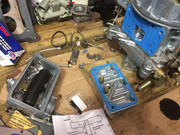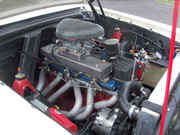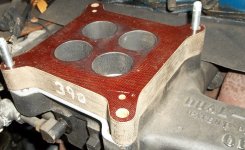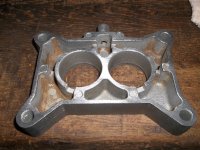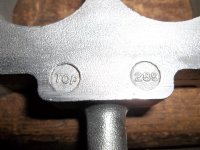Yup, very rich. That makes sense. It’s when the vacuum gauge gets pegged and more fuel is sucked through the carburetor than necessary. I can verify this by thinking back on my ‘66 F-100 360 4bbl with headers Granny 4-speed. There were rust holes in the collectors and I could see flames through the floorboard when I let off of it.
The smaller diameter spacer holes probably make it more pronounced (Venturi effect?)
The intake will consist of two separate plenums,
1 into 3 like a reverse V-6 equal length header, Welded quarter inch thick aluminum ‘boxes’ with air directors inside. Each one will use a Motorcraft 2bbl. Fuel mixture issues will be lessened considerably.
I have an ‘82 Fairmont Futura, 200 automatic. The engine is sound; quiet, smooth, no smoke. This manifold is for a small six.
OK! Sorry, I didn't connect the dots on the custom intake. Nice!
Yes the high vacuum is pulling max fuel thru the idle circuit, and that's rich. But the primary source of the decel flooding is the high volume of air/fuel that's already in the intake when the throttle is snapped shut. Now there's too much fuel and the airstream has been cut off. All that has to work it's way thru the cylinders and it does it slowly since it's choked off at the top. The high vacuum on the idle screws contributes to the condition, but is not the primary source. The more volume an intake has, the worse the decel flooding. The factory log, it's barely discernable. The DP intake has enough decel flooding to affect drivability, it's an unavoidable side effect of the design.
An open spacer is the worst for increasing plenum volume and decel flooding. They aid top-end power though.
Single hole (per barrel) is better in two ways. Decel flooding is reduced since plenum is reduced relative to open spacer. And the now straightened-out descending air/fuel mix maintains good velocity into the intake, helping fuel particle suspension and cly-to-cyl distribution. With the smoothed-out flow, the carb base "sees" a more stable vacuum, which may aid in accurate internal metering function. Spacer holes which match the carb throttle size are ideal, and I suspect a spacer that smooth-tapered down to 10% or so smaller at the intake would benefit an economy-based build.
Generic off-the-shelf spacers have holes which are too big for all but the max size carbs. I've had this issue on every application, since I'm using a small carb on a mild performance 6. Would probably require a dyno to see the difference between spacer bores larger than carb bores over matched bores. But bigger bores bug me because of the turbulent micro-physics occurring in the fuel/air stream at the sharp "ledge" at the base of the carb where it transitions abruptly into the larger spacer bore. Plus the slight loss of downward inertia and slight increased volume, undesirable on a mild street-operated engine.
I found a phenolic spacer with the correct bore size for the tiny 390 4V on ebay. Sold (used) by a NASCAR team, used on the races where carb is limited to 390 cfm. (It's a nice piece!) An upcoming upgrade to '79 F100, found a 2V spacer with nearly matching bores for the 350 2V Holley on ebay, off a '60's Ford 289, was a factory piece. Double benefit on the 289 spacer, has the PCV port. Something neither the Aussispeed intake nor the base of the 40 year old carb had.

